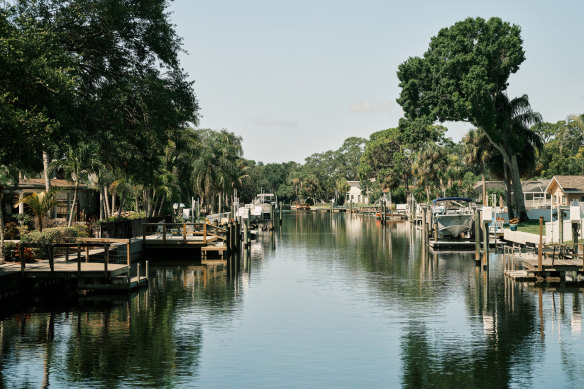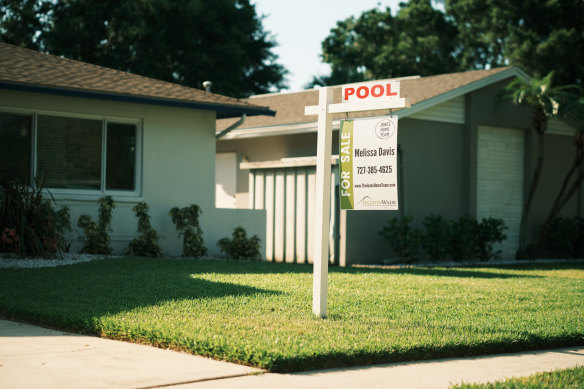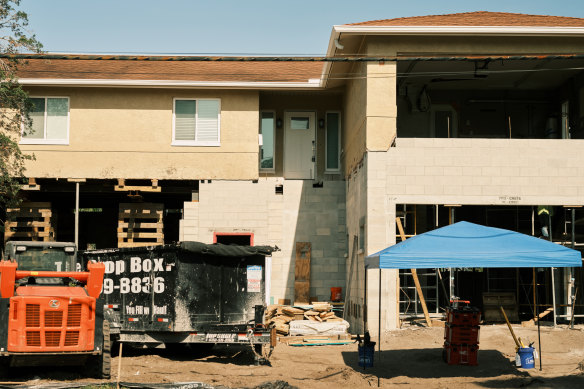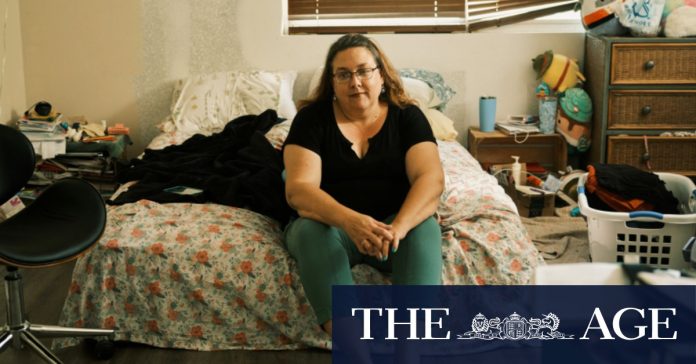[ad_1]
But many residents, like Connell-Wandstrat, cannot afford to lift up their homes or retreat. Even with considerable equity in their homes – Connell-Wandstrat, a tutor whose husband died in 2018, has lived there for 22 years – they are unlikely to find another place they can afford in Shore Acres or a similar neighbourhood, given how much property values and mortgage rates have increased.
“I’m here for the foreseeable future,” Connell-Wandstrat said.

Shore Acres, a low-lying enclave at the edge of Tampa Bay where streets are broad, homes are comfortable – and floodwater has become a constant threat.Credit: Zack Wittman/The New York Times
The neighbourhood is leafy and walkable, near good schools and close to downtown St. Petersburg and Tampa, which sits across the bay. A large recreation centre hosts community activities. A local Facebook group is incredibly active; after Hurricane Idalia, neighbours offered to do each other’s laundry and recommended reliable contractors.
Connell-Wandstrat, 51, bought in Shore Acres because it struck her as a gem, populated by doctors and lawyers but also teachers and nurses. The less affluent, however, are more vulnerable: the neighbourhood is shaped like a bowl, with the more modest homes lying low in the middle.
Back when some of those homes were built in the mid-20th century, the city could only recommend, not require, a certain elevation, said Claude Tankersley, St. Petersburg’s public works administrator. Today, with high-tide flooding rapidly increasing in the Gulf of Mexico, parts of Shore Acres take on water even on sunny days. On a recent afternoon, pools formed at both ends of Connell-Wandstrat’s block.
After Hurricane Idalia, residents pressed the city to do more. St. Petersburg has since started to install nearly $4 million worth of new equipment to prevent saltwater from pushing up into drainage pipes in the neighbourhood, with more projects planned.

“For sale” signs dot almost every block in Shore Acres.Credit: Zack Wittman/The New York Times
Still, Tankersley said that the projects underway were “a Band-Aid”. Everyone in Shore Acres knows that the best solution other than leaving is to build higher, which can cost hundreds of thousands of dollars. The Federal Emergency Management Agency has a program to assist, but applying is a lengthy process that requires going through the city and state.
Since 1996, St. Petersburg, a city of about 260,000, has helped raise 13 homes, Tankersley said, with another one currently being elevated and 14 more in the pipeline.
“To talk about such a drastic change as having to elevate your home and the cost involved, it’s a scary thing,” he said. “We recognise that that’s going to take a long time.”
Melissa Watson, 46, a surgical nurse, bought her cheery blue house in 2021. She left Ohio for Florida in 2018 after surviving cancer and a divorce. She had lost bids for 17 other houses before her offer was accepted in Shore Acres.

A home in Shore Acres in the process of being raised onto concrete pillars.Credit: Zack Wittman/The New York Times
“I didn’t really understand the gravity of the flooding that had occurred in this area until after I signed on the dotted line,” she said.
Forty-six centimetres of water flooded her home during Hurricane Idalia, forcing Watson and her teenage son to bounce between friends’ houses, Airbnbs and hotels for eight months.
To fix the water damage, insurance offered to pay $US52,000 to $US58,000 ($78,000 to $87,000); contractors told her the work would cost $US65,000 to $US75,000. She could not afford to elevate the house but raised her air conditioner and power outlets with an eye towards the next flood.
Loading
“My neighbours are selling. I don’t have neighbours across the street. There’s a monstrosity being built right behind me,” she said. “I fear for what this neighbourhood is going to end up like.”
Kevin Batdorf, the president of the Shore Acres Civic Association, has pushed city and state leaders to find more ways to keep residents in their homes. He said people had been quoted anywhere from $US250,000 to $US400,000, depending on the square footage, to lift their home and reconfigure its electrical and plumbing systems.
Batdorf, a real estate broker, said people were still buying in the neighbourhood, even if only to demolish and rebuild. He likened the situation to when Tropical Storm Josephine flooded Shore Acres in 1996. Batdorf walked through knee-deep water back then to make sure a house his clients wanted had not flooded. The flooding did not detract the buyers.
“I wrote the contract that day, in the water,” he said. “People love living here. It’s the convenience of where it is. It’s paradise.”
Kitty Bennett contributed research.
This article originally appeared in The New York Times.
[ad_2]
Source link


